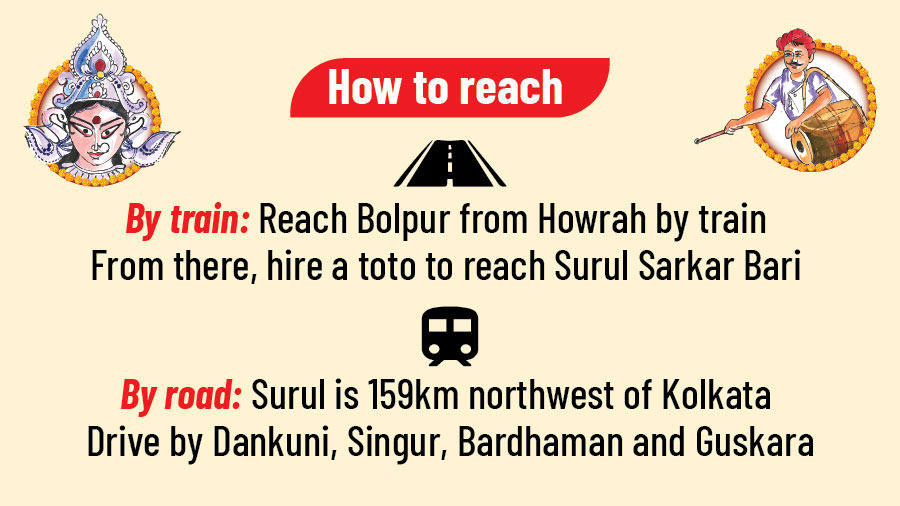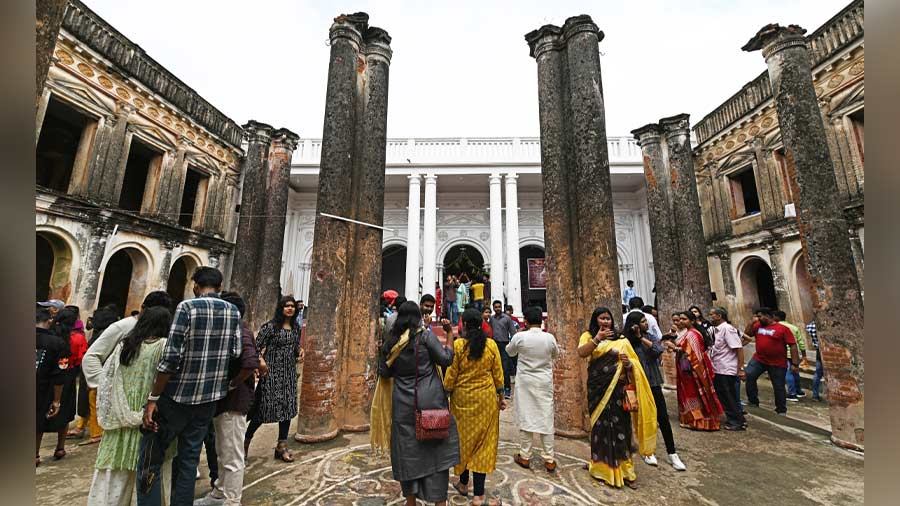If you are at Surul Sarkar Bari on Saptami, be prepared to polish your dodging and catching skills and be sure to pocket some sweet treats. As the nabapatrika procession enters the house to the strains of agomoni gaan, elder members of the family shower sirir naru (sweets made of gramflour) from the first-floor balcony as a part of ‘Harir looth’.
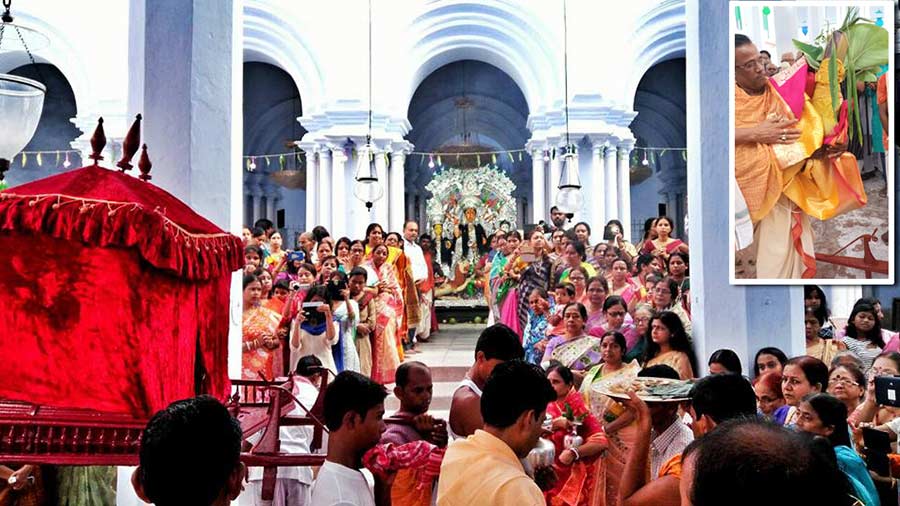
At Surul Sarkar Bari, both the Nabapatrika are taken in a palanquin accompanied by musicians, sentries and family members for the bath at a waterbody. (Inset) Later, the ‘nabapatrika’ is being adorned with a Banarasi saree Surul Raj Bari
Celebrated inside a grand mansion with five arched Durga dalan and a huge nat mandir (pillared hall) studded with chandeliers made of Belgian glass along with its unique rituals, the Durga Puja of the Surul Sarkar family near Santiniketan is sure to lift your spirits during the autumn festivity season. During the Puja days, the Belgian glass chandeliers are lit with manual lamps using rerir tel (castor oil).
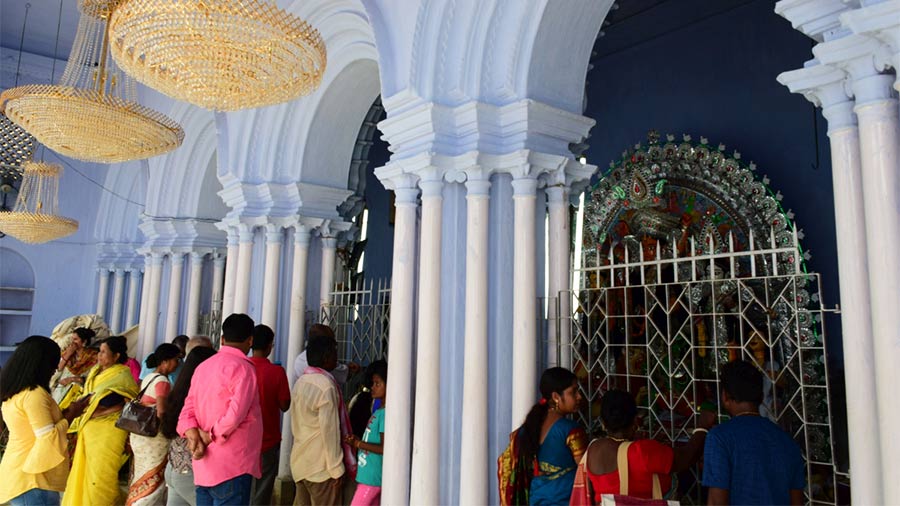
The grand ‘thakur dalan’ inside Surul Sarkar bari premises Amitabha Gupta
Sarkar Bari of Surul has two Durga Puja conducted in their family. One is their ancestral Puja conducted inside the Surul Raj Bari premises which will be celebrating its 289th year currently, known as ‘boro tarof’ puja and one in a thakur dalan outside the premises known as ‘choto taraf’ puja celebrated for around 100 years.
Saradindu Sarkar of Surul Sarkar Bari says that the nabapatrika rituals of the family are a treat to watch. Both the nabapatrikas are carried one after another in palanquins accompanied by musicians, priests and family members to the nearby pond. After the bathing rituals of the nabapatrika alias ‘kola bou’ are done, it is draped in a Banarasi saree. The procession with the nabapatrika comes back to the residence in a similar manner. As they enter, the house elder members throw sirir naru (sweets made of gram flour) from the first-floor balcony as a part of ‘Harir Looth’. In the background, agomoni song is sung to welcome the goddess, a tradition which is seldom followed now.
The deity of ‘boro taraf’ is an ekchala thakur adorned in daaker saaj, a decoration of silver foil (rangta) enhanced with silver sequins and bejewelled with gold and silver ornaments. The deity of ‘choto taraf’ is adorned with Banarasi saree and ornaments of similar make. Though the same ritual is followed, the puja of ‘boro taraf’ puja starts earlier. The skin tone of goddess Durga is ‘taptakanchanbarna’ or blazing golden colour. The chaal chitra displays scenes of marriage of Shiva and Durga and other religious themes. The same kathamo (idol frame) is used year after year and the deity is made indigenously with clay without using any mould.
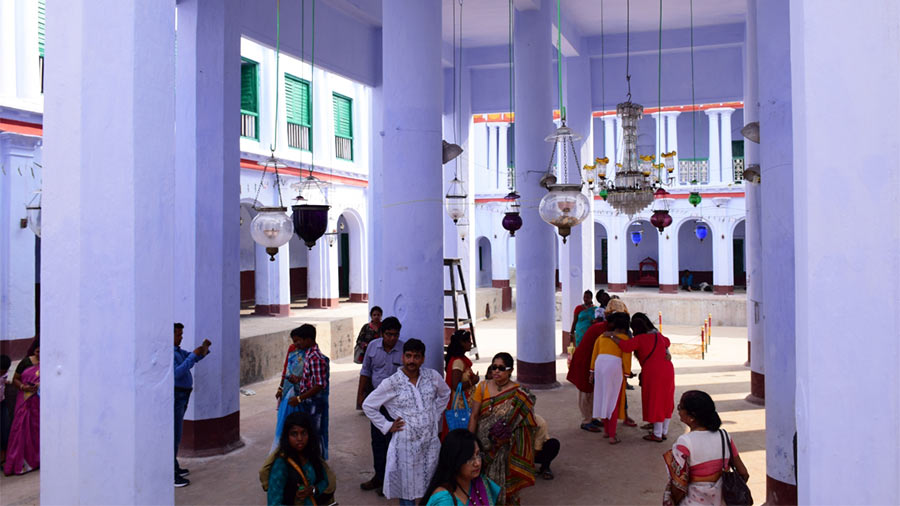
Belgian glass chandeliers and lamps hang from the ceiling of the ‘nat mandir’ at Surul Sarkar Bari. The lamps are lit manually using castor oil Amitabha Gupta
The Durga Puja of the family was started by Bharat Chandra Ghosh who originated from Nilpur in Burdwan district. His son, Krishnahari, had three children. Of them, Jadabendra and Kalicharan conduct the ‘boro taraf’ puja and Madhabendra conducts the ‘choto taraf’ puja.
Srinivas, a descendant of this family prospered by doing business with John Chip, a resident of the East India Company, in the local trading house of Surul in the 18th century. The family used to manufacture thick cloth known as ‘garah kapor’. They also traded in sugar and indigo. Apart from the English and British, the cloth was exported even to Myanmar, Sri Lanka, Egypt and other European countries. The ‘Sarkar’ title was provided by the English Residency to Srinivas. Srinivas Sarkar built the palatial Surul residential house with thakur dalan and nat mandir in the 18th century.
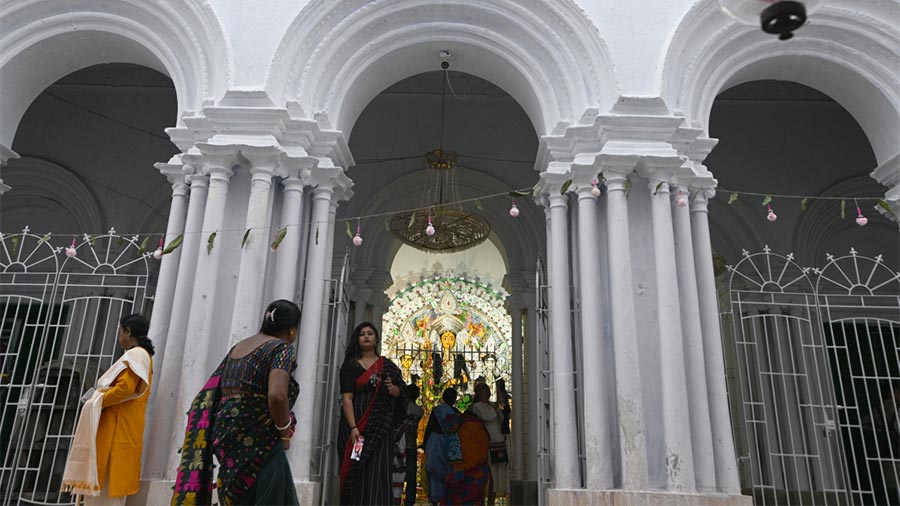
Visitors at Surul Sarkar Bari ‘Durga dalan’ during Durga Puja Anjan Kumar Kundu
Bodhon (welcoming the goddess) starts on Sasthi at Surul Sarkar Bari. The family deity, Narayan Salgramsila, is brought from Narayan temple located inside the interiors of Surul Raj Bari in a small procession and put on thakur dalan besides goddess Durga. Interestingly, though the Durga Puja is celebrated following Vaishnav rituals there is practice of animal sacrifice on Ashtami till date.
Following ancient traditions, ash gourd is sacrificed on Saptami, a goat on Ashtami and twin sugarcane and ash gourd on Navami. After the animal sacrifice on Ashtami, the sacrificial falchion is taken to the nearby Manasa temple in a procession to sacrifice another lamb there. During animal sacrifice, Narayan deity is shifted away from the thakur dalan back to his temple. He is brought back again on Navami.
Earlier, before Ashtami Pujo, there was a ritual of firing a gun, which has ceased to exist. Surul Sarkar Bari is one of few family-run Durga Pujas, where the musical instrument dhaak is not played during the Durga Puja. It is substituted with dhol accompanied by kansor and shehnai. The members of the family dance as the music is played in the background.
The food offering to the goddess includes uncooked rice, various fruits, luchi (deep-fried puffed bread) and a plethora of homemade sweets like sirir naru, chonar naru, narkel naru, pantua, kamala bhog, mihidana, monda, chhena and batasa. Sugar and jaggery are also offered. Chire (flattened rice), khoi (toasted paddy) and curd are also offered to the goddess.
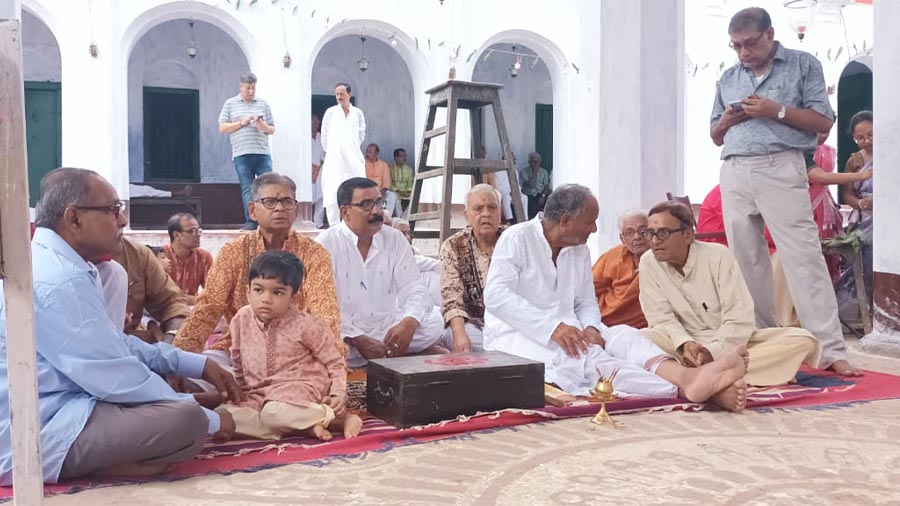
On Dashami, family members sit on the ‘nat mandir’ and contribute whatever each members can afford into a donation box for the family Durga Puja Surul Sarkar Bari
A unique tradition, which is still maintained in Surul Sarkar Bari during Durga Puja, is that local open-air theatre named ‘jatra’ is still performed in the evening on Saptami, Ashtami and Navami.
During day time on Dashami, family members sit at the nat mandir and contribute whatever each members can afford into a donation box for the family Durga Puja. The Durga Puja is conducted by a trustee board. ‘Boro taraf’ and ‘choto taraf’ have separate trustee boards.

A crowd of devotees and family members accompany Surul Sarkar Bari’s ‘baro taraf’ deity for her immersion on Dashami Surul Raj Bari
During Dashami, there is a ritual of worshipping the Aparajita tree. After the worship, leaves of the tree are tied to their arm by devotees with a thread. This is supposed to bring good luck. At the end of Dashami puja, Narayan is taken back to his temple, where the priest blows conch to invite Brahminy Kite as a tradition for good luck. Then the ghot is brought to the ancestral house of the Sarkar family.
During immersion of the goddess, the deity of ‘choto taraf’ is given the first preference. There is no contemporary style of sindur khela or dhunuchi naach during immersion of the idol. Earlier the deity was carried physically by menfolk. Now, a trolley is used. However, the deities are carried from the thakur dalan to the trolley only by male members of the Surul Sarkar Bari.
